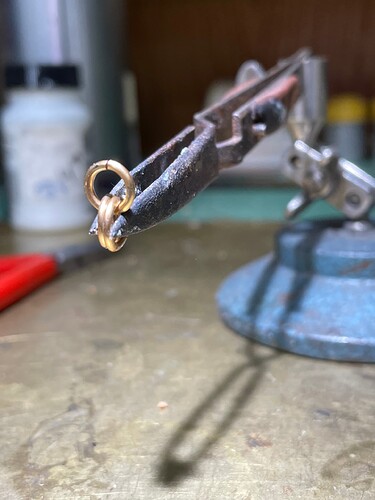Hi guys!
Quick question, I’ve been working on a sterling silver curb chain and I have soldered each joint in each jump ring before I twisted the chain. Sometimes the joint breaks when I twist the chain which I’m used to. I have been finding however, when I go back to resolder the broken joint, other (non broken) jump rings solder have completely disappeared when I reheat the piece. Some of the solder seems like it’s gone, or the joint is starting to reopen just from being heated. I have never found this problem before and I’m not sure why suddenly I have to go back and resolder these jump rings that I soldered before.
I’m sorry if I’m not making much sense, but I was hoping someone out there may be able to help me figure out why this is suddenly happening.
Thank you for your time and any help is appreciated:)
Ava
Once in a while, it seems that I forget how to solder. I have learned to stop, clean the bench, make new pickle, clean and refill my flux jar, clean the torch tips, scrape down the soldering blocks, clean off my tweezers, clean what solder I can and some times add a coating of flux to it, take a break and start over. It usually works. Specific to your question, make sure that you are using the right solder and fluxing it well. I am not sure what you mean by twisting it, but anneal the entire chain before you twist so that you don’t run into hard spots that will stress the joints. When I make chain, which isn’t very often. I separate the un-soldered links into two piles. I solder half of them separately before I assemble the chain with hard solder, then assemble the chain and solder the rest with medium solder. It’s easier and you have less of a chance of the heat from soldering one link effecting the one next to it. Let us know how you solve your problem. Good luck…Rob
2 Likes
Rob and I have discussed this very issue several times. And we, he and I, solve the problem the same way, following the same steps he has outlined. And I believe our Dad had this phenomena happen to him as well. I think it happens to all of us and we develop solutions that may be unique to each of us. My additional rule is anytime I have the same mistake three times in a row I am done. I make coffee, grab a guitar and head for the porch.
On my bench I have noticed much of my soldering issues usually go back to the torch being too hot. When butt soldering to lengths of 10 ga. wire, a simple process we all do at times, I will have what appears to be a perfect joint. But when it is bent the joint fails. When I look at the joint it appears the solder flowed only around the outside of the wire and did not penetrate to the center of the joint. I think a torch that is too hot will bring the outside of the wire to temperature but the center wasn’t at temperature yet. The solder flows where the heat is and I have failed joints and drink a lot of coffee.
Besides cleaning the bench, pickle, and solder picks I spend time with the torch listening for tell tale sounds that tell me the torch is hot enough, or too hot as the case may be. The torch may be the right temperature but I haven’t given it enough time to penetrate the work. Or there is too much, or not enough, O2 in the mix. The right amount of gas and too much O2 changes the sound of the burn. And for me the sound is critical which is counter intuitive for a guy with a hearing loss across several frequencies.
Good luck and have fun.
Don Meixner
5 Likes
I’m here to help…
I learned how to make chains from a chain specialist many years ago. I really do enjoy making them. Yeah. I know I’m kinda sick that way 
For starters What type and temperature of solder are you using? What kind of flux and what kind of torch are you using? Are your links work hardened or annealed when you solder? Also are you isolating the links from each other as you solder them like this? And finally are you cleaning up/removing excess solder from the links as you go?
2 Likes
Solder contains components that vaporize at high temperatures. Different manufacturers use different alloy recipes. One company’s Medium Silver Solder might melt at a different temperature from others.
Since the lower temperature metals basically evaporated, the solder in a joint can “disappear”. Pitting and other surface issues also happen due to this.
Solutions:
Get in, get out.- Use a torch with sufficient heat. Preheat if possible. Silver sucks up heat like nobody’s business and conducts it elsewhere.
Protect seams.- If possible protect seams with yellow ochre or old style whiteout. (Newer types are sometimes difficult to remove.) This isn’t just for preventing parts from soldering together, but helps with vaporizing.
Stay hard.- Use Hard solder for as much as possible. There is less Zinc (or whatever) in Hard solder. That means less evaporation. Since parts of the alloy go up the vent, the melting point of the solder rises. This makes it possible to solder again with the same and NOT melt a joint.
Some of this is more challenging given the intricacies of chains, but you might experiment with solder from different sources.
Ruthanne Robertson
2 Likes

